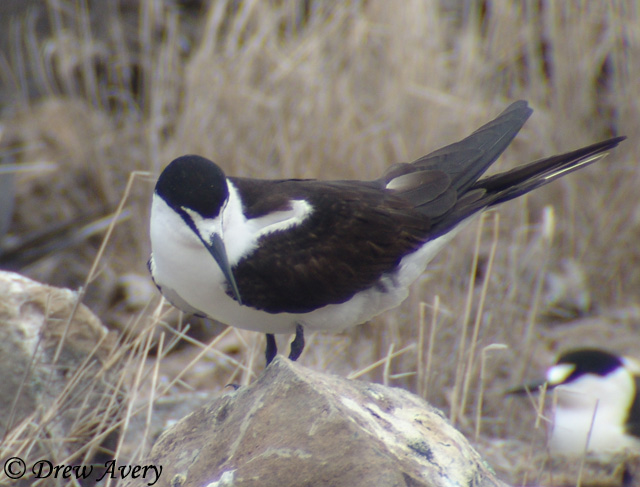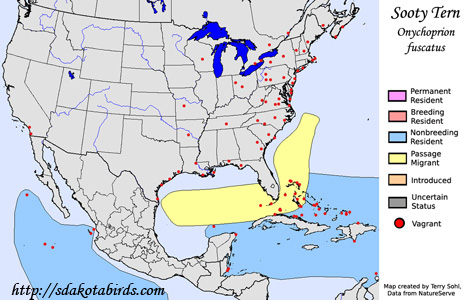| Length: 16 inches | Wingspan: 32 inches | Seasonality: Non-resident in South Dakota |
| ID Keys: Dark upperparts, white underparts, black cap and nape, black stripe through eye | ||
 The
Sooty Tern is a beautifully plumage tern with crisp black-and-white
markings. They are similar in appearance to the closely related
Bridled Tern, but have darker plumage, are slightly larger, and are the more
common species in North America. Sooty Terns can be found as nesting
birds on small islands throughout much of the tropical oceans of the world.
In the United States, nesting birds are found on the Hawaiian Islands, but
in the continental U.S., the only location to find nesting birds are on the
Dry Tortugas islands on the west end of the Florida Keys.
The
Sooty Tern is a beautifully plumage tern with crisp black-and-white
markings. They are similar in appearance to the closely related
Bridled Tern, but have darker plumage, are slightly larger, and are the more
common species in North America. Sooty Terns can be found as nesting
birds on small islands throughout much of the tropical oceans of the world.
In the United States, nesting birds are found on the Hawaiian Islands, but
in the continental U.S., the only location to find nesting birds are on the
Dry Tortugas islands on the west end of the Florida Keys.
Habitat: Found on small tropical islands during the nesting season, preferring islands with open ground and little vegetation. Outside of the breeding season, they disperse widely across warm waters in the tropical oceans.
Diet: Feeds on fish, and sometimes on small squid or other marine creatures.
Behavior: Forages by flying low over the surface of the water, dipping down to the surface to grab food items. They will often concentrate in areas where predatory fish are feeding and driving small fish to the surface.
Nesting: The nest of a Sooty Tern is a shallow scrape on the ground, sometimes lined with a bit of vegetation. The female lays a single egg, and both parents help to incubate it. When the egg hatches, both parents help to feed the youngster regurgitated fish.
Song: Has a variety of nasal, laughing or rasping calls.
Migration: Found as a nesting bird on small islands throughout much of the tropical oceans. Outside of the nesting season, often found far from land, dispersing widely across the tropical oceans. Adult birds nesting in the Dry Tortugas in Florida mostly disperse to the Gulf of Mexico or to the Caribbean after nesting.
Interactive eBird map: Click here to access an interactive eBird map of Sooty Tern sightings
Similar Species: Most similar to the Bridled Tern. Plumage is rather distinctive compared to other tern species.
Conservation Status: Populations are widespread and common in many areas. The IUCN lists the Sooty Tern as a species of "Least Concern".
Further Information: 1) Wikipedia - Sooty Tern
2) Birdlife International - Sooty Tern
3) Audubon Guide - Sooty Tern
Photo Information: Photo taken by Drew Avery - January 18th, 2009 - Ascension Island - Photo licensed under Creative Commons Attribution 2.0 Generic License..
| Click below for a higher-resolution map |
 |
| South Dakota Status: Non-resident in South Dakota |
Additional Sooty Tern Photos (coming soon!!)
